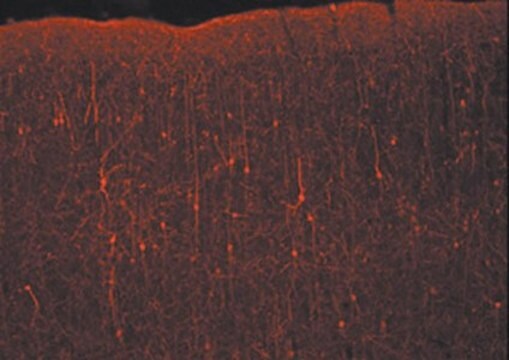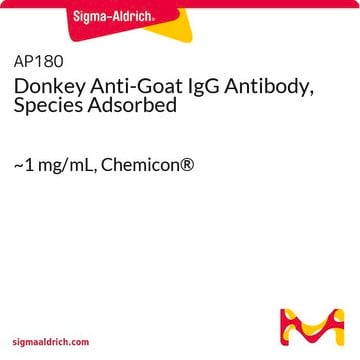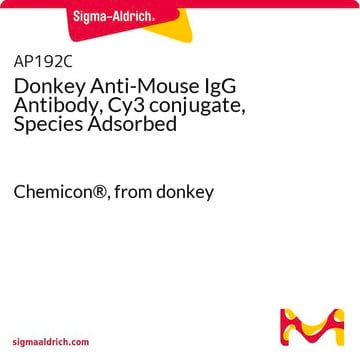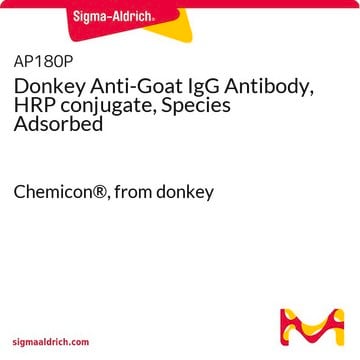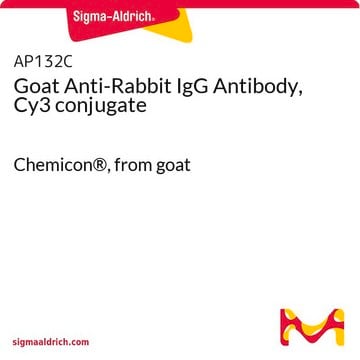AP180C
Donkey Anti-Goat IgG Antibody, Cy3 conjugate, Species Adsorbed
Chemicon®, from donkey
Sign Into View Organizational & Contract Pricing
All Photos(1)
About This Item
UNSPSC Code:
12352203
eCl@ss:
32160702
NACRES:
NA.46
Recommended Products
biological source
donkey
Quality Level
conjugate
CY3 conjugate
antibody form
F(ab′)2 fragment of affinity isolated antibody
antibody product type
secondary antibodies
clone
polyclonal
species reactivity
goat
manufacturer/tradename
Chemicon®
technique(s)
immunofluorescence: suitable
shipped in
wet ice
target post-translational modification
unmodified
Related Categories
General description
Immunoglobulin G (IgG), is one of the most abundant proteins in human serum with normal levels between 8-17 mg/mL in adult blood. IgG is important for our defence against microorganisms and the molecules are produced by B lymphocytes as a part of our adaptive immune response. The IgG molecule has two separate functions; to bind to the pathogen that elicited the response and to recruit other cells and molecules to destroy the antigen. The variability of the IgG pool is generated by somatic recombination and the number of specificities in an individual at a given time point is estimated to be 1011 variants.
Specificity
Goat IgG
Application
Research Category
Secondary & Control Antibodies
Secondary & Control Antibodies
Research Sub Category
Secondary Antibodies Adsorbed for Dual Labeling
Secondary Antibodies Adsorbed for Dual Labeling
This Donkey anti-Goat IgG Antibody, Cy3 conjugate, Species Adsorbed is validated for use in IF for the detection of Donkey Goat IgG.
Legal Information
CHEMICON is a registered trademark of Merck KGaA, Darmstadt, Germany
Disclaimer
Unless otherwise stated in our catalog or other company documentation accompanying the product(s), our products are intended for research use only and are not to be used for any other purpose, which includes but is not limited to, unauthorized commercial uses, in vitro diagnostic uses, ex vivo or in vivo therapeutic uses or any type of consumption or application to humans or animals.
Not finding the right product?
Try our Product Selector Tool.
Hazard Statements
Precautionary Statements
Hazard Classifications
Aquatic Chronic 3
Storage Class Code
11 - Combustible Solids
WGK
WGK 3
Certificates of Analysis (COA)
Search for Certificates of Analysis (COA) by entering the products Lot/Batch Number. Lot and Batch Numbers can be found on a product’s label following the words ‘Lot’ or ‘Batch’.
Already Own This Product?
Find documentation for the products that you have recently purchased in the Document Library.
Timothy Su et al.
Molecular carcinogenesis, 56(2), 761-773 (2016-08-02)
It is unclear if proximal and distal traditional adenomas present with differences in molecular events which contribute to cancer heterogeneity by tumor anatomical subsite. Participants from a colonoscopy-based study (n = 380) were divided into subgroups based on the location of their
Holger Dannenberg et al.
The Journal of neuroscience : the official journal of the Society for Neuroscience, 39(18), 3434-3453 (2019-02-26)
The firing rate of speed cells, a dedicated subpopulation of neurons in the medial entorhinal cortex (MEC), is correlated with running speed. This correlation has been interpreted as a speed code used in various computational models for path integration. These
Jianying Zhang et al.
Journal of orthopaedic research : official publication of the Orthopaedic Research Society, 30(1), 47-52 (2011-06-21)
Tendon stem cells (TSCs) have been proposed to play a major role in the development of tendinopathy, which refers to pathological changes, such as calcification, in affected tendons. Using a human TSC (hTSC) culture model, this study investigated the effects
Tomokazu Konishi et al.
PloS one, 13(2), e0192955-e0192955 (2018-02-21)
Although lipoproteins are conventionally separated into a few classes using density gradient centrifugation, there may be a much higher number of physical classes that differ in origin or phase. Comprehensive knowledge of the classes of lipoproteins is rather limited, which
Ian A White et al.
Circulation research, 117(12), 990-994 (2015-09-16)
Although mammalian cardiac regeneration can occur in the neonatal period, the factors involved in this process remain to be established. Because tissue and limb regeneration require concurrent reinnervation by the peripheral nervous system, we hypothesized that cardiac regeneration also requires
Our team of scientists has experience in all areas of research including Life Science, Material Science, Chemical Synthesis, Chromatography, Analytical and many others.
Contact Technical Service